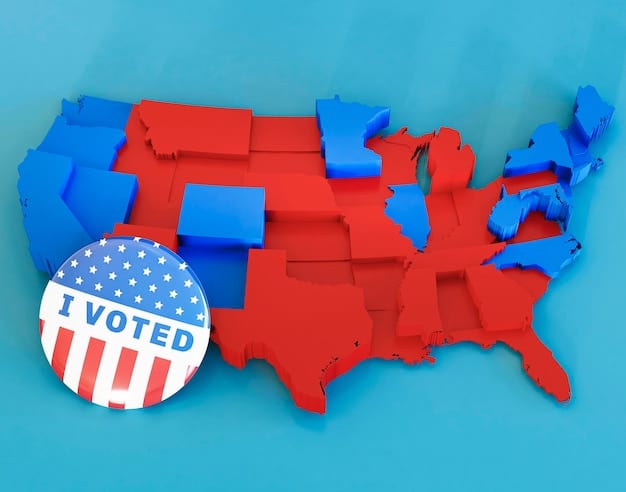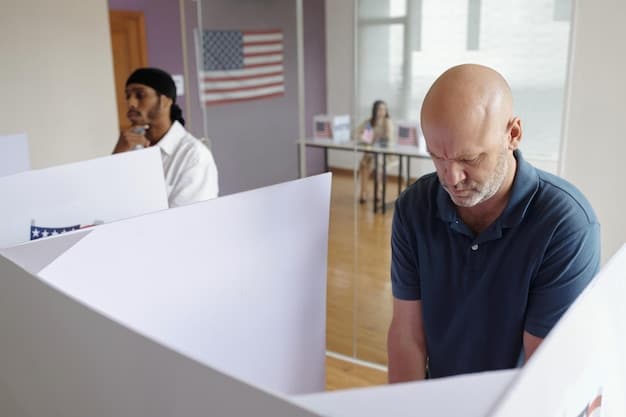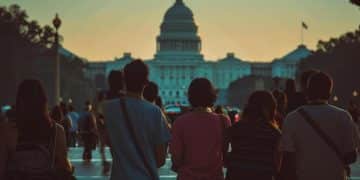Voter ID Laws: Impact on 2025 Elections & State Comparison

Voter ID laws vary significantly across states, potentially influencing voter turnout in the 2025 elections by imposing different identification requirements that could disproportionately affect certain demographics.
The debate surrounding voter ID laws: A state-by-state comparison of requirements and their potential effect on the 2025 elections continues to be a contentious issue in American politics. These laws, which require voters to present identification at the polls, have sparked intense discussion regarding their potential impact on voter turnout and accessibility to the democratic process. As we approach the 2025 elections, it’s crucial to examine how these laws differ from state to state and to understand their possible consequences.
Understanding Voter ID Laws Across the US
Voter ID laws are not uniform across the United States. They range from strict photo ID laws, which require voters to present a photo identification card, to more lenient non-photo ID laws, which allow voters to use documents such as utility bills or bank statements. Understanding these differences is crucial for assessing their potential impact on the 2025 elections.
Types of Voter ID Laws
- Strict Photo ID Laws: These require voters to present a valid photo ID, such as a driver’s license or passport, in order to cast a ballot. States with strict photo ID laws often have provisions for voters who do not have an acceptable ID, such as allowing them to cast a provisional ballot.
- Non-Strict Photo ID Laws: These allow voters without a photo ID to cast a ballot if they sign an affidavit or are identified by another registered voter.
- Non-Photo ID Laws: These allow voters to present non-photo identification, such as a utility bill, bank statement, or other document with their name and address.
- No ID Required: In some states, no identification is required to vote; voters simply need to register.

The variation in these laws reflects differing priorities among state legislatures. Some argue that strict laws are needed to prevent voter fraud, while others contend that they disproportionately disenfranchise minority voters, low-income individuals, and the elderly, who may have more difficulty obtaining the required identification. The specific types of IDs accepted and the accommodations made for those without ID also vary.
The Potential Impact on the 2025 Elections
The impact of voter ID laws on election outcomes is a subject of ongoing debate and research. Some studies suggest that these laws can decrease voter turnout, particularly among certain demographic groups. Other studies argue that the impact is minimal or that the laws are necessary to ensure election integrity. Regardless, voter ID laws are a focal point and potentially decisive factor in election results.
Arguments for Voter ID Laws
Proponents of voter ID laws argue that they are essential to prevent voter fraud, maintain the integrity of elections, and increase public confidence in the democratic process. They claim that voter ID laws are a reasonable measure to ensure that only eligible voters are casting ballots and that these steps safeguard the democratic process.
- Preventing Voter Fraud: Voter ID laws are seen as a deterrent to voter impersonation and other forms of fraud.
- Maintaining Election Integrity: Ensuring that only eligible voters participate helps uphold the legitimacy of election results.
- Increasing Public Confidence: Voter ID laws can boost public trust in the fairness and accuracy of elections.

Arguments Against Voter ID Laws
Critics of voter ID laws argue that they disproportionately disenfranchise minority voters, low-income individuals, and the elderly, who may have difficulty obtaining the required identification. They also argue that voter fraud is rare and that these laws are a form of voter suppression.
- Disproportionate Impact: Voter ID laws can create barriers for those who lack the necessary identification.
- Voter Suppression: Critics view these laws as a deliberate attempt to reduce voter turnout among specific groups.
- Limited Evidence of Fraud: Opponents point out that voter fraud is rare, making the laws an unnecessary burden.
The debate over voter ID laws reflects fundamental disagreements about the balance between election security and voter access. As the 2025 elections approach, understanding these arguments is crucial for evaluating the potential consequences of these laws.
A State-by-State Comparison
To provide a clearer picture of the landscape, this section will offer a state-by-state comparison of voter ID laws. This will include information on the specific types of identification required, the accommodations made for voters without ID, and any recent changes to the laws. The 2025 elections might well hinge on state specifics.
Below is a detailed breakdown of some key states and their voter ID requirements. This comparison aims to highlight the diversity in voter ID policies and their potential effects on different populations.
Key States and Their Voter ID Requirements
- Texas: Requires a strict photo ID, such as a driver’s license, passport, or military ID. Limited alternatives are available for those without photo ID.
- Georgia: Voters must present a photo ID. Those without an acceptable ID can vote with a provisional ballot, which will be counted if the voter provides valid identification within a specified timeframe.
- Wisconsin: A strict photo ID law is in effect. Voters without ID can obtain a free ID from the Department of Motor Vehicles.
- North Carolina: Requires a photo ID. Voters can cast a provisional ballot if they do not have an ID, and their ballot will be counted if they provide an acceptable ID later.
- California: Does not require voter ID. Voters are only required to provide their name and address when voting.
Understanding these state-specific requirements is essential for assessing the potential impact on voter turnout and election outcomes in 2025.
Recent Changes and Legal Challenges
Voter ID laws are frequently subject to legal challenges and legislative changes. Understanding these developments is crucial for assessing the current landscape and anticipating future changes. Activists on both sides are constantly seeking out revisions that favor their preferred outcome.
Recent years have seen numerous court cases challenging the constitutionality and legality of voter ID laws. Here’s a look at some significant legal battles:
Notable Legal Challenges
- Shelby County v. Holder (2013): The Supreme Court struck down a key provision of the Voting Rights Act, which had required certain states with a history of discrimination to obtain federal approval before making changes to their voting laws. This decision led to a wave of new voter ID laws and other voting restrictions.
- Texas Voter ID Law: The Texas voter ID law has been the subject of numerous legal challenges, with courts repeatedly finding that it discriminated against minority voters. Despite these challenges, the law remains in effect with some modifications.
- North Carolina Voter ID Law: North Carolina’s voter ID law was struck down by a federal appeals court, which found that it was enacted with discriminatory intent. However, the law has since been reinstated with some changes.
These legal battles underscore the ongoing controversy surrounding voter ID laws and their potential impact on the right to vote. As we approach 2025, understanding these legal challenges is essential for assessing the current landscape and anticipating future changes in voter ID policies.
The Role of Technology in Voter Identification
Technology is playing an increasingly important role in voter identification. From electronic poll books to mobile ID apps, innovations are being explored to improve the security and efficiency of the voting process. But every “fix” opens up new conversations as well.
Technological solutions aim to streamline the voter identification process, reduce the risk of fraud, and improve voter access. Here are some key technological advancements:
Technological Solutions
- Electronic Poll Books: These replace traditional paper poll books and allow election officials to quickly verify voter registration information.
- Mobile ID Apps: Some states are exploring the use of mobile ID apps, which would allow voters to present a digital version of their driver’s license or other identification on their smartphones.
- Biometric Identification: Biometric technologies, such as fingerprint scanners, are being considered as a way to verify voter identity and prevent fraud.
The implementation of these technologies raises questions about privacy, security, and accessibility. It’s important to carefully consider these issues as we move towards a more technologically driven voting system. Furthermore, the digital divide is ever more prominent for people with limited technological literacy.
Looking Ahead to the 2025 Elections
As we approach the 2025 elections, voter ID laws will continue to be a significant factor in the political landscape. Understanding the state-by-state differences, the legal challenges, and the potential impact on voter turnout is crucial for ensuring a fair and accessible democratic process. Awareness and education are fundamental.
Several key issues are likely to shape the debate over voter ID laws in the lead-up to the 2025 elections:
Key Considerations for 2025
- Legislative Changes: State legislatures may introduce new voter ID laws or make changes to existing ones.
- Court Decisions: Ongoing legal challenges could result in significant changes to voter ID policies.
- Voter Education Efforts: Efforts to educate voters about ID requirements and how to obtain the necessary identification will be crucial for ensuring high voter turnout.
By staying informed about these developments, we can better understand the potential consequences of voter ID laws and work towards a more inclusive and equitable electoral system. Every voice matters, and the right to vote forms the backbone of the democracy.
| Key Element | Brief Description |
|---|---|
| 🔑 Types of Voter ID Laws | Includes strict photo ID, non-strict photo ID, and non-photo ID laws. |
| ⚖️ Arguments For & Against | Proponents cite fraud prevention, while opponents mention disenfranchisement risks. |
| 🗺️ State-by-State Differences | Laws vary greatly; some states require strict photo IDs, others none. |
| 📱 Technology’s Role | Electronic poll books and mobile ID apps streamline voter identification. |
Frequently Asked Questions
▼
A voter ID law requires voters to present some form of identification at the polls before they are allowed to cast a ballot. The type of identification required varies by state.
▼
These laws are controversial because they may disproportionately affect minority voters, low-income individuals, and the elderly, who may find it more difficult to obtain an acceptable ID.
▼
States such as Texas, Georgia, and Wisconsin are considered to have some of the strictest voter ID laws, requiring voters to present a valid photo ID at the polls.
▼
Research on the impact of voter ID laws on turnout is mixed. Some studies suggest that these laws can decrease voter participation, particularly among certain demographic groups.
▼
Many states offer alternatives for voters without ID, such as allowing them to cast a provisional ballot or sign an affidavit affirming their identity. The specific options vary by state.
Conclusion
In conclusion, voter ID laws: A state-by-state comparison of requirements and their potential effect on the 2025 elections, represent a complex and evolving aspect of the American electoral system. As we approach the 2025 elections, understanding the nuances of these laws, their potential impacts, and the ongoing debates surrounding them is essential for all citizens.



